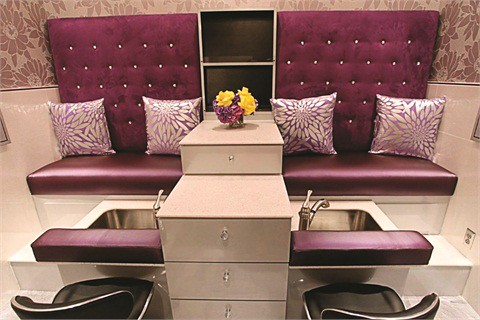What is the Beauty & Nail Salons Industry?
A nail salon or nail bar is a beauty services establishment that primarily offers nail care services such as manicures, pedicures, and nail enhancements. Often, nail salons also offer skin care services. There are approximately 9,900 nail salons (2010) in the U.S., up 23% from 2007 according to the “AnythingResearch Nail Salon report.”. (http://www.anythingresearch.com/industry/Nail-Salons.htm) The industry is estimated with a market size (includes all money spent in the salon on the services in the chart at the top right) of 6.6 million dollars in the year of 2011. (http://files.nailsmag.com/Market-Research/NAILSstats11-12.pdf)
Nail salons offer a variation of options for nail care. This includes acrylics, silk or fiberglass wraps, French manicures, polish, pedicures, etc. Some nail salons are offering one-stop beauty services. In addition to nail services, these one-stop nail salons offer facial treatments, waxing, and skin care.

Nail salon industry could be considered as a very typical industry that could use a lot of revenue management, regarding to : 1) the high fix costs and low flexible costs of producing, 2) the perishability of the inventory, 3) the easiness to control duration, and 4) the capability to manage demand by pre-selling and fencing rates.
However, based on my research, “time” has been an implicit pricing component for most of the nail salons inside of the U.S., and in most cased, price are still being decided based on techniques and materials applied for a certain service.
Industry Practice – Pricing Strategies
In the current industry practical, most of the prices are neither defined by space nor time. Instead, the price are defined by the service and material consumed. A widely accepted pricing method in the industry is that the product costs cannot exceed 6% of the service charge. To figure the minimum charge per service, multiply the product cost for each service by 16.5. The figure is the lowest possible price for a service.
For nail salons pricing base on technician, an “85% rule” are commonly accepted. The salon figure station occupancy by dividing hours booked by hours scheduled. For example, if the nail technician is scheduled for 40 hours per week and is pre-booked for 30 of those hours, she has a 75% station occupancy rate. When that technician is fully booked more than 85% of the time, the salon will consider raising her price. (http://www.nailsmag.com/article/92584/the-big-payoff)
- Rate fences
Rate fences that have been being utilized in the industry are limited. Some of the nail salons have already started to use last minute deal and early reservation to fence the rates. However, for most of the salons, no rate differences or slight differences will be charged by making early reservation and walk-ins.
The good part is that selling the inventory ahead of the time by making reservations and bookings has already become an industry norm. The research shows that about 40% of the nail salons do not take walk-in businesses. Some salons are also using daily deals to fence their rate to the last minute businesses to spread the demand evenly, such as Polished Nail Salon (http://www.polishednailsalon.net/Special-Deals.html)
We can find some of the industry pioneers already moved their feet into the gate of revenue management and try to control its inventory by “selling” time or space, such as Isle Pedi. Even though no specific example was made, it has been said that some of the salons have already started to charge a flat “slot fee” plus an “add-on fee” for the services received. Several examples were selected to reflect the diversity of pricing policies and strategies.
No time component + Mostly Tech oriented
AVALON Hair & Nail Salon (http://avalonhairandnailsalon.com/services.html)
Crystal Nail Salon (http://www.crystalnailsalon.com/pricelist.html)
Partially time + Partially Tech oriented
Gaia (http://www.gaiasalon.com/waxing-and-nails.html)
— Some, especially high end, salons would charge by nail instead of by hand, based on the costs of each nail and provide more variety in design.
Mostly time oriented pricing
The Emerald Door (http://emeralddoorsalon.com/treatments.html)
Isle PediSpa (http://www.islepedispa.com/pedicures.htm)
Demographic component pricing
Berkshire (http://www.berkshiresalondayspa.com/nails)
- Potential solutions
People have been trying out new stuff and reaching out beyond the industry to get inspired. I spotted a lot of good practices in setting rate fences, such as by gender and age, which are all very well accepted by the customers. Also some of the salons are taking good advantages of group selling by providing “manicure/pedicure parties” and therefore add more value in the service by providing princess/night club costumes and other entertainment services.
A good example would be Manicure/Pedicure Group Party – R2C Kids Spa (http://rotten2thecorekidzspa.vpweb.com/Party-Packages.html)

Industry Practice – Define Space and Time
Space
- Selling space explicitly or implicitly?
Most of the nail salons are selling space implicitly. The price is decided mostly basd on the labor and material spent on a certain service. For example, one customer who received “polish changes” and “Gel” will not pay less than two customers who receive these two services separately, even though the latter requires two “slots” and the former requires one.
- Practices to define space and other possible solutions
Normally nail salon would separate the space into: reception desk, waiting area (both for drying the nails and for waiting for the next available tech); manicure area; pedicure area; and massage area/private room. Some, especially high end, nail salons also have retail area.
Among those areas, manicure area, pedicure area, private rooms, and retail area are considered revenue generating areas. To implement revenue management, the salon could define its inventory as “slot” and focus on improve “revenue per slot”, or as “square feet” and define the performance metric as “revenue per sq”. The latter one makes more sense to me, seeing as it includes the gross booth area into consideration and reflects the overall profitability of the salon.
To divide the space into different layers could be a crucial approach to fence the price and maximize the profit. A higher scale salon requires bigger space for each “slot”, while a bigger “slot” should be charged with a higher premium to compensate the cost of space. As what we applied in restaurant revenue management, the space allocation should be balanced between the functionality and the profitability. Therefore, nail salons should not only divide the space by function, as what most of the nail salons are doing, but also should divide the space by service scales based on its customer mix and needs.

One interesting finding is that, catering to the special needs of the “girls’ collectivism”, a lot of nail salons designed conjunction seats. (http://www.nailsmag.com/article/94720/one-of-a-kind-spa-expands-to-three) As you can find in the picture, this seat conjunction is called “purple princess suite”, specially designed for two girl friends / couple/ parent-kid who would like to share their pedicure time with each other. The conjunction seats not only save space and therefore increase unit space revenue, but also cater to the certain clienteles’ special needs. You will not get one of those hot babies without making a reservation.
- Additional revenue generate space

Retail area could constitute a major additional revenue generate space for nail salons. A goal of comprising 15% of the total revenue is realistic for the nail technician and profitable for the salon. (http://www.nailsmag.com/article/92584/the-big-payoff)
For example, Isle Pedi Spa had 2,700 square feet space and allocated 400 square feet to its retail section, which features over 600 different shades of high-end polish to purchase. Also available are candles, bath bombs, nail care products, neck wraps, flip flops, sandals, and all of the salon’s house-blended products. (http://www.nailsmag.com/article/94720/one-of-a-kind-spa-expands-to-three)
Another large source of income could be from gift certificates. Clients will love them because they’re already packaged nicely so they make great and easy gifts. Gift certificates are the best advertising because they get someone new through the door.
Time
- Selling time explicitly or implicitly
Yes and no. Nail salon industry has been selling the inventory ahead by making reservations yet traditionally the industry does not sell its inventory explicitly by time.
- Practices to sell time and other possible solutions
As it has been listed above, different practices have been implemented to sell the time. Take Isle Pedi as an example, services around 45 minutes belong to one rate layer while services around 60 minutes belong to another time layer.
Actually, a lot can be done to make the business more profitable once the business owners start to focus on utilizing their limited operation time on hand more efficiently. Therefore, the profitability efficiency can be measured by “revenue per half hour” or “revenue per hour”, whatever the smallest time unit is. By clearly defining and controlling the service duration, the business owners can make accurate forecast and sell the inventory by chunk with prices adjusted by demand. The suggestion is to study the history record made by your salon. How many customers you get by the Day of the Week, and how many reservations you got for each day compare to the walk-in businesses. Then we can implement the hotel room revenue management application into the forecasting and pricing for nail salon industry, to decide how many walk-ins to take, with what rate and alike.

By realizing the significance of the time component in profitability, the business owners can also try to fill up the waiting gap in the process of service to improve the performance of revenue per time unit. A great example would be Le Posh (http://www.salonleposh.com/just-for-her/posh-packages/) As it is shown by the picture, Le Posh is providing manicure service while the clients are getting a perm.
However, whether this application is acceptable totally depends on the client tail. In the case of Chi&Ki Sister Nail Salon, they figured that with an affluent clientele, folks would want to slow down and be pampered. However, as it turns out, even these clients are generally on the run. So, Chi has an ad hoc set up for mani-pedis to be done together. But at Ki, comfortable manicure tables were built into the custom pedicure benches from the start. (http://www.nailsmag.com/article/94592/on-the-road-ki-nail-bar-organic-spa-los-angeles)
- Explicitly example
Isle PediSpa (http://www.islepedispa.com/pedicures.htm)

Worth to mention, Isle PediSpa did a great job with its pricing structure design. Everything is derived from a basic “45 min/$38 rate” service. Packages providing different callus work are priced with 5/10/15 dollar premium to the basic rate; also a quick 30 min variety, a kids variety, and a male variety are provided with slight price differences from the basic service; another price layer is the “1 hour” packages that are priced with slight differences around 60 dollars.
Non-traditional Revenue Management Practice in Nail Salon Industry
- Selling the Time and Space in a better way
- A better rate fences: providing different booking windows, “good only when combination with”, or time limited deals. An even better idea would be a reservation center that collect all the demand and supply on a single platform, just like expedia.com for hotel industry.
- Time Range Bookings: Offer some guests the opportunity to receive a reduced rate if they can be flexible with the time they take their treatment.
- Last Minute Deals: Drive impulse and walk-in business to these times and turn what would have been idle labor expenses into reduced rate treatments.
- Controlled Discounting: Instead of charging a premium during the busy times, establish higher prices overall and provide variable discounts.
- Controlled Availability: Create booking rules to encourage high margin treatments during high demand periods.
- Combination Menu
The key to revenue management for nail salon is how to do balance between price, space, and time to be in line with perishable inventory and variable demand. Therefore, as we discussed previously in this article, there could be a lot of combinations of practices to price the time and the space.
A lot of experiments and researches are waited to be done to find out the best practice. Will it be better to sell time explicitly while selling space implicitly? Or will it be better to sell both of them explicitly? The answer may surprise us when it comes to the real world in different market segments and different geographic locations.
2. Concerns of acceptance level and perceived fairness
A “small” nail business could get pretty complex in the terms of pricing. Therefore to find out a way to deliver and explain the pricing structure to the customers is very important. I suggest the business owners to design a menu like the menu in a restaurant: for red curry base, you could have tofu, beef, seafood and chicken with slightly different prices; if you want brown rice instead of white rice, pay extra. In nail salons, we can have 45 minutes base and slightly different priced options; if you want celebrity brand instead of private brand, then pay a little bit of extra.
Also, charging the customers by the space they take still sounds a little bit avant garde. It may raise the complexity of the pricing structure and hard to acquire acceptance from customers. Customers in a restaurant will be outrageous if they were asked for a “slot fee”, a “food fee” and a “service fee”. What we can do is to provide customers bigger and more comfortable chairs/sofa only when they choose to purchase a longer service and/or more expensive services, until the perceived fairness of being charged by space raised to a safe threshold.



